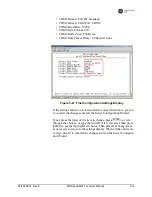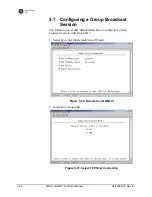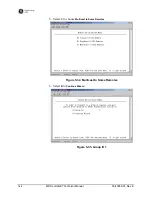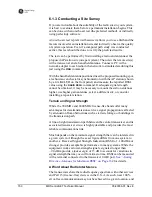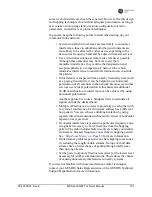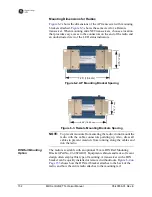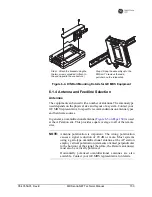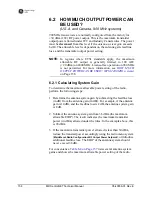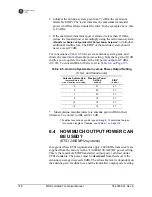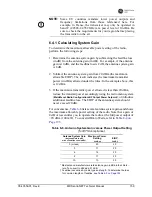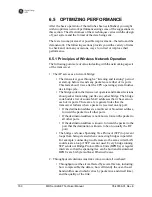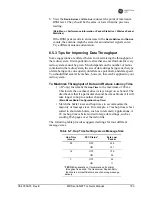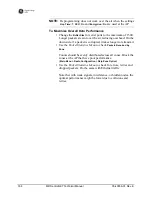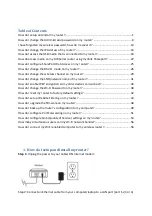
150
MDS entraNET Technical Manual
05-4055A01, Rev. E
6.1.3 Conducting a Site Survey
If you are in doubt about the suitability of the radio sites in your system,
it is best to evaluate them before a permanent installation begins. This
can be done with an on-the-air test (the preferred method), or indirectly
using path-study software.
An on-the-air test is preferred because it allows you to see firsthand the
factors involved at an installation site and to directly observe the quality
of system operation. Even if a computer path study was conducted
earlier, this test should be done to verify the predicted results.
The test can be performed by first installing a radio and antenna at the
proposed AP station site (one per system). Then visit the remote site(s)
with a transceiver and a hand-held antenna. Connect a PC with a
network adapter to each radio in the network to simulate data during this
test using the
PING
command.
With the hand-held antenna positioned near the proposed mounting spot,
a technician can check for synchronization with the AP station (shown
by a lit
LINK
LED on the front panel) and measure the reported RSSI
value using the
RADIO RSSI=
command. If adequate signal strength
cannot be obtained, it may be necessary to mount the station antennas
higher, use higher gain antennas, select a different site, or consider
installing a repeater station.
Terrain and Signal Strength
While the 900 MHz and 2400 MHz license-free bands offer many
advantages for data transmission services, signal propagation is affected
by attenuation from obstructions such as terrain, foliage, or buildings in
the transmission path.
A line-of-sight transmission path between the central transceiver and its
associated transceiver site
(
s
)
is highly desirable and provides the most
reliable communications link.
Much depends on the minimum signal strength that can be tolerated in
a given system. Although the exact figure differs from one system to
another, a Received Signal Strength Indication (RSSI) of –100 dBm or
stronger provides acceptable performance in many systems. While the
equipment works at lower-strength signals, signals stronger than
– 90 dBm provide a
fade margin
of 15 dB to account for variations in
signal strength that may occur from time to time. RSSI can be measured
with a terminal connected to the transceiver
COM1
port.
See
“Aiming
Directive Antennas for Maximum RSSI”
on Page 162
for details.
A Word About Radio Interference
The transceivers share the radio-frequency spectrum with other services
and Part 15 (license-free) devices in the U.S.A. As such, near 100%
error-free communications may not be achieved in a given location, and
Summary of Contents for MDS entraNET 900
Page 10: ...LA N CO M1 CO M2 PW R LIN K viii MDS entraNET Technical Manual 05 4055A01 Rev E...
Page 12: ...2 MDS entraNET Technical Manual 05 4055A01 Rev E LA N CO M1 CO M2 PW R LIN K...
Page 24: ...14 MDS entraNET Technical Manual 05 4055A01 Rev E LA N CO M1 CO M2 PW R LIN K...
Page 26: ...16 MDS entraNET Technical Manual 05 4055A01 Rev E LA N CO M1 CO M2 PW R LIN K...
Page 38: ...28 MDS entraNET Technical Manual 05 4055A01 Rev E LA N CO M1 CO M2 PW R LIN K...
Page 110: ...100 MDS entraNET Technical Manual 05 4055A01 Rev E LA N CO M1 CO M2 PW R LIN K...
Page 130: ...120 MDS entraNET Technical Manual 05 4055A01 Rev E LA N CO M1 CO M2 PW R LIN K...
Page 156: ...146 MDS entraNET Technical Manual 05 4055A01 Rev E LA N CO M1 CO M2 PW R LIN K...
Page 158: ...148 MDS entraNET Technical Manual 05 4055A01 Rev E LA N CO M1 CO M2 PW R LIN K...
Page 176: ...166 MDS entraNET Technical Manual 05 4055A01 Rev E LA N CO M1 CO M2 PW R LIN K...
Page 186: ...176 MDS entraNET Technical Manual 05 4055A01 Rev E LA N CO M1 CO M2 PW R LIN K...
Page 188: ...178 MDS entraNET Technical Manual 05 4055A01 Rev E LA N CO M1 CO M2 PW R LIN K...
Page 204: ...194 MDS entraNET Technical Manual 05 4055A01 Rev E LA N CO M1 CO M2 PW R LIN K...
Page 218: ...I 8 MDS entraNET Technical Manual 05 4055A01 Rev E...




